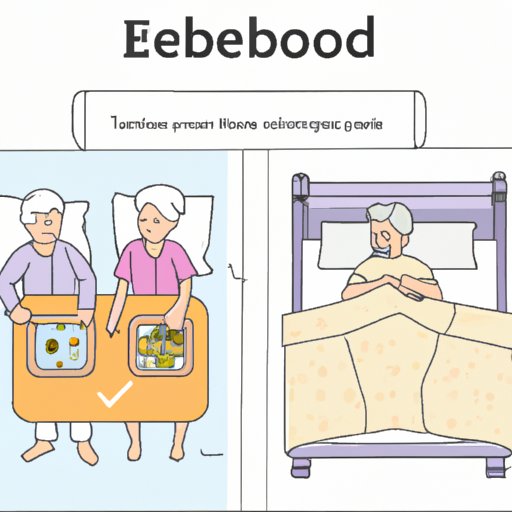Introduction
Bedridden elderly care refers to the care of elderly individuals who spend most of their time in bed due to physical disability or serious illness. Taking care of a bedridden elderly person at home can be a challenging task, but with the right approach, it is possible to ensure that they remain comfortable and safe. This article will explore how to provide bedridden elderly care at home, including tips on ensuring proper comfort and positioning, monitoring food and fluid intake, maintaining cleanliness, encouraging socialization and stimulation, avoiding overheating or chilling, providing exercise, and monitoring for health changes.

Ensuring Proper Comfort and Positioning
One of the main goals of caring for a bedridden elderly person is to ensure their comfort. To do this, start by investing in quality pillows and mattress toppers. Pillows and toppers should be thick enough to cushion and support the body, yet soft enough to provide comfort. Additionally, consider using items such as wedges, body pillows, and foam rolls for extra support.
Once you have the necessary supportive items, position them around the bedridden elderly person to ensure that their spine and joints are properly aligned. Make sure to adjust the position regularly to avoid pressure points or discomfort. Additionally, periodically reposition the individual to prevent bedsores.
Monitoring Food and Fluid Intake
It is important to make sure that the bedridden elderly person is eating adequately. Offer nourishing and easy-to-digest foods, such as soups, smoothies, and pureed vegetables. Provide snacks throughout the day to increase caloric intake. If the individual has difficulty swallowing, consult a doctor for advice on how to safely feed them.
In addition to eating, it is essential to monitor fluid intake. Encourage the individual to drink plenty of fluids throughout the day, such as water, tea, and juice. If they are unable to drink on their own, offer assistance with straws or bottles. Monitor urine output to ensure that they are consuming enough fluids.
Maintaining Cleanliness
Cleanliness is an important aspect of bedridden elderly care. Change the bedding regularly to keep the area hygienic and free of bacteria. Additionally, pay attention to the skin. Clean and dry the skin daily to avoid irritation or infection. Use gentle soaps and moisturizers to keep the skin healthy.
Encouraging Socialization and Stimulation
Socialization and stimulation are important for the overall well-being of the bedridden elderly person. Engage in conversations with them and ask questions about their life. Read stories aloud and watch movies together. If the individual is able, encourage them to participate in activities from bed, such as playing card games or doing puzzles.
Avoiding Overheating or Chilling
The elderly are more prone to drastic temperature changes, so it is important to keep the environment comfortable. Monitor their body temperature and adjust clothing, blankets, and room temperature accordingly. If the individual feels too hot or cold, take steps to address the issue.
Exercise
Exercise is an important part of bedridden elderly care. Even if the individual is not able to move around much, stretching and range of motion exercises can help maintain flexibility and muscle strength. Consult a doctor or physical therapist for advice on which exercises are suitable for the individual.
Monitoring for Health Changes
Finally, keep an eye out for signs of illness or discomfort. Monitor symptoms such as fever, vomiting, and diarrhea. Also, look out for changes in appetite, energy levels, and behavior. If any of these signs are present, contact a doctor immediately.
Conclusion
Caring for a bedridden elderly person at home can be challenging, but with the right approach, it is possible to ensure that they remain comfortable and safe. This article explored how to provide bedridden elderly care at home, from ensuring proper comfort and positioning to monitoring for health changes. Tips on maintaining cleanliness, encouraging socialization, and avoiding overheating or chilling were also provided.
(Note: Is this article not meeting your expectations? Do you have knowledge or insights to share? Unlock new opportunities and expand your reach by joining our authors team. Click Registration to join us and share your expertise with our readers.)
